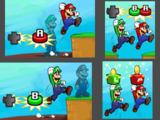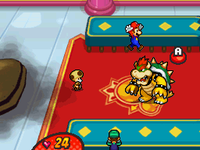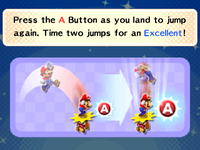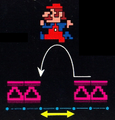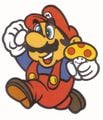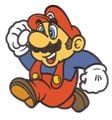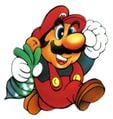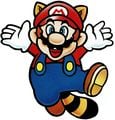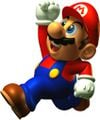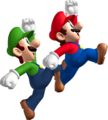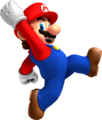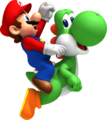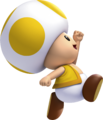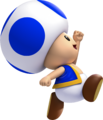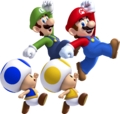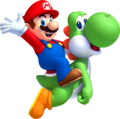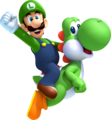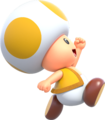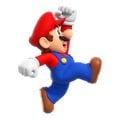Jump: Difference between revisions
| Line 28: | Line 28: | ||
====''Super Mario Bros. 2''==== | ====''Super Mario Bros. 2''==== | ||
In ''[[Super Mario Bros. 2]]'', jumps served a different purpose than in all other games, due to the game using the only slightly altered ''[[Yume Kōjō: Doki Doki Panic]]'' as its engine. The characters in the game could not defeat any enemies by stomping on them. Instead, they could stand on them and pick them up by pressing {{button|nes | In ''[[Super Mario Bros. 2]]'', jumps served a different purpose than in all other games, due to the game using the only slightly altered ''[[Yume Kōjō: Doki Doki Panic]]'' as its engine. The characters in the game could not defeat any enemies by stomping on them. Instead, they could stand on them and pick them up by pressing {{button|nes|b}}. Players could even land on [[Birdo]]'s [[Birdo's Egg|eggs]] and throw them at Birdo. Enemies and items could be picked up and thrown to knock out other enemies. This system has been carried over to ''Donkey Kong'' on the Game Boy. | ||
====''Super Mario World''==== | ====''Super Mario World''==== | ||
Revision as of 10:43, October 22, 2020
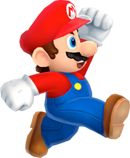
- “As you know, the primary action for mobile creatures is the jump, if you follow.”
- —Stuffwell, Mario & Luigi: Partners in Time
Jumping is Mario's most commonly used move. While it was originally only used to evade obstacles in the original Donkey Kong game, it has been Mario's primary method of attacking since Super Mario Bros. Depending on the type of game, Mario and other characters jump for a variety of different purposes. When Mario jumps, he makes a fist in the air and splits his legs at the same time.
Because Mario can jump in nearly all of his games, only significant examples are mentioned on this page.
History
Donkey Kong series
Donkey Kong
In the original arcade version of Donkey Kong, Mario has to jump over the barrels that Donkey Kong throws at him. He can only jump high enough to leap right over the barrel, in contrast to the impossibly high jumps in the Super Mario Bros. series. If Mario lands on a barrel in the game, he dies. In the early concept of Donkey Kong, Mario originally was not able to jump. It was implemented when Shigeru Miyamoto and his team thought, "If you had a barrel rolling towards you, what would you do?"[1]
Donkey Kong (Game Boy)
In Donkey Kong on the Game Boy, Mario has a greater variety of moves related to jumping. If the player jumps then presses down on , Mario does a handstand. From the handstand position, Mario could perform high jumps and wide jumps depending on the situation. Mario could also backflip by walking and then immediately pressing the opposite direction and the jump button, resulting in him going high into the air backwards. Unlike all other 2D Mario titles, Donkey Kong also punishes the player for falling too far, resulting in Mario losing a life. This jump system has also been used in Mario vs. Donkey Kong.
Mario Bros.
In Mario Bros., jumping is the primary attack of Mario and Luigi and the only way to defeat enemies. By jumping from below to hit the platforms on which the enemies stand, the player can stun the enemies or turn them around. The enemies then have to be finished off with a kick. Unlike later games, stomping on enemies is deadly in Mario Bros. Because of this, the Shellcreepers have been changed to Spinies in all remakes of the game to remind players not to stomp on them.
Super Mario series
Since Super Mario Bros., jumping has been a much more integral part of the Mario franchise, and is no longer used solely to jump over gaps and enemies. In later games of the series, Mario and other playable characters use a greater variety of jump moves which can be used to reach certain areas or get bonus items from special blocks. These include the Spin Jump from Super Mario World, the Ground Pound first seen in Super Mario World 2: Yoshi's Island, and even the Double Jump, Triple Jump, and Wall Jump introduced in Super Mario 64.
Super Mario Bros.
Super Mario Bros. features various types of Brick Blocks which Mario can find coins in, as well as ? Blocks that contain Magic Mushrooms and Fire Flowers. To break these blocks, the player must jump while under them. Mario can also defeat enemies like Little Goombas and Hammer Brothers by stomping on them. Koopa Troopas are not defeated by the stomp, but hide in their Shells, which can then be kicked by the player. Hammer Brothers, Cheep-cheeps, fake Bowsers, and Bowser himself all jump in the game as well.
Super Mario Bros. 2
In Super Mario Bros. 2, jumps served a different purpose than in all other games, due to the game using the only slightly altered Yume Kōjō: Doki Doki Panic as its engine. The characters in the game could not defeat any enemies by stomping on them. Instead, they could stand on them and pick them up by pressing . Players could even land on Birdo's eggs and throw them at Birdo. Enemies and items could be picked up and thrown to knock out other enemies. This system has been carried over to Donkey Kong on the Game Boy.
Super Mario World
While the standard jump remains mostly unchanged in Super Mario World, Mario is also now capable of Spin Jumping. It trades height for offence, as it can break blocks (as Super Mario) and destroys enemies that are usually more durable. It also allows Mario to bounce off of certain enemies, notably those with spines, where he would usually take damage.
Super Mario World is the debut of Yoshi, a dinosaur-like creature Mario can ride. His jump is greater than Mario's, but defeats enemies as quickly as the Spin Jump, and Yoshi even bounces on spiny enemies, too. While on Yoshi, the player can perform a Yoshi Boost[2], which is a double jump off of Yoshi. Doing this will render Yoshi alone unless hopped on again.
Super Mario World 2: Yoshi's Island
The playable appearance of Yoshi, Super Mario World 2: Yoshi's Island, introduces multiple aspects on top of the jump. By holding the jump button, Yoshi will Flutter Jump, which stalls him momentarily, allowing for careful landings and covering greater distances. Pressing down makes him Ground Pound, an offensive move that is stronger than landing on enemies. These are all new to the franchise, with Ground Pounding becoming a staple of Super Mario Bros. games, and Flutter Jumping being an iconic move of Yoshi's.
Super Mario Sunshine
In Super Mario Sunshine, Mario's jump can defeat most enemies. When using F.L.U.D.D.'s Hover Nozzle, Mario can float higher and longer. In addition, if Mario loses health, his jumps become weaker[citation needed]. Also, if Mario jumps over a pit, his jumps are different.
Mario Kart series
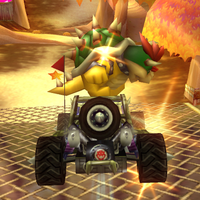
In Super Mario Kart, players can hop with the press of a button. The Feather allows them to do a high jump. Hops can be used to cross gaps and to take shortcuts. In later games of the Mario Kart series, jumping is usually only possible when using ramps. In Mario Kart Wii, Mario Kart 7, Mario Kart 8, Mario Kart 8 Deluxe and Mario Kart Tour, it is possible to do tricks after jumping off, giving players a mediocre boost in Mario Kart Wii, and a short boost in Mario Kart 7, Mario Kart 8, Mario Kart 8 Deluxe, and Mario Kart Tour.
Super Mario RPG: Legend of the Seven Stars
In Super Mario RPG: Legend of the Seven Stars, the Jump is a special move that requires 3 Flower Points. It does additional damage as a Timed Hit, and its power increases with the Jump Shoes. Mario can use this move from the beginning of the game. Mario's jump is also used by many characters in the game to verify his identity. Everyone also seems to think of it as his most defining characteristic.
Paper Mario series
Jumping is present in every installment of the Paper Mario series.
In Paper Mario and Paper Mario: The Thousand-Year Door, jumping is Mario's primary attack he can use from the beginning of the game. It can be used to defeat any kind of generic enemy like the Goombas, but some enemies like the Spiked Goombas prevent jump attacks with spikes, and the player then has to use the Hammer attacks instead. Jumping is also used on the overworld for platforming elements. In both games, Mario can increase his jump power and abilities with the Super Boots and the Ultra Boots. Doopliss also uses Mario’s jump attack in battle when he copies Mario.
In Super Paper Mario, all four characters have the ability to jump on foes as their primary means of attack.
Paper Mario: Sticker Star features multiple Jump stickers that can be used in battle, each with various strengths. There are seven different types of Jumps, each with their own variations: the Jump, Iron Jump, Hopslipper, Infinijump, Line Jump, and Clone Jump. All of these types except the Infijump and Clone Jump reappear as cards in Paper Mario: Color Splash, along with a new variation, the Spin Jump.
Mario & Luigi series
Mario & Luigi: Superstar Saga / Mario & Luigi: Superstar Saga + Bowser's Minions
Mario & Luigi: Superstar Saga used the same concept for jumps as the Paper Mario series. In addition, the player controls both Mario and Luigi simultaneously using ![]() , with Luigi in tow following Mario's movements. Each brother has their own corresponding button –
, with Luigi in tow following Mario's movements. Each brother has their own corresponding button – ![]() for Mario and
for Mario and ![]() for Luigi – and it is necessary to use both to get both brothers over pits. On the overworld, Mario and Luigi could also perform the High Jump and the Spin Jump to reach higher areas. Many Bros. Attacks also use jump moves. Mario & Luigi: Superstar Saga + Bowser's Minions retains this.
for Luigi – and it is necessary to use both to get both brothers over pits. On the overworld, Mario and Luigi could also perform the High Jump and the Spin Jump to reach higher areas. Many Bros. Attacks also use jump moves. Mario & Luigi: Superstar Saga + Bowser's Minions retains this.
Some enemies and bosses resist jump or hammer attacks, even if they are spiky.
Mario & Luigi: Partners in Time
In Mario & Luigi: Partners in Time, the jump command was identical to how it was in Mario & Luigi: Superstar Saga, however, the piggyback jumps with Baby Mario and Baby Luigi increased the number of jump commands in-battle. The Spin Jump returns, and later on the bros learn the Baby Spin move which allows them to Spin Jump into the babies to launch them even further upwards and makes it possible for them to cross large gaps along with the adult bros. Like Mario and Luigi, the player controls both Baby Mario and Baby Luigi simultaneously using the while they are separated from their older selves. The two babies also have their own corresponding button -
![]() for Baby Mario and
for Baby Mario and ![]() for Baby Luigi.
for Baby Luigi.
Mario & Luigi: Bowser's Inside Story / Mario & Luigi: Bowser's Inside Story + Bowser Jr.'s Journey
In Mario & Luigi: Bowser's Inside Story and Mario & Luigi: Bowser's Inside Story + Bowser Jr.'s Journey, jumping in battles works similar to how it did in Mario & Luigi: Partners in Time when the adult brothers are with their infant counterparts; Mario and Luigi can perform two jumps with a well-timed action command, dealing twice the damage to enemies. In the overworld, jumping functions the same as it always had in previous games, though there are also 2D side-scrolling segments that take place inside Bowser's body, where the jumps use the mechanics of Mario & Luigi jumping in a typical Super Mario Bros. setting.
Mario & Luigi: Dream Team
In Mario & Luigi: Dream Team, the Jump attacks for Mario and Luigi are identical in gameplay to the ones in Mario & Luigi: Bowser's Inside Story, down to the 2D areas, although in the Dream World, successful Jump attacks cause several Luiginoids to fall on to surrounding enemies after Mario attacks for extra damage. In the overworld, this game uses the Jump field action as usual for the series, and features the Spin Jump and the Ball Hop, a move very similar to the High Jump from Mario & Luigi: Superstar Saga, and seems to be a combination of the aforementioned move and the Ball Bros. move from Mario & Luigi: Partners in Time. The Luiginoid Generator also uses the Jump action while in the Luiginoid Stack formation.
The Jump attack is also used during the Giant Battles by Giant Luigi, the result of Dreamy Luigi and many Luiginoids' combination. This involves Luigi first bobbing down as if he was about to spring into the air, where the player must wait until Luigi flashes to slide up quickly on the Touch Screen. Perfect timing allows Luigi to land firmly on the target and perform a second jump on them if the player succeeds in repeating the command. Perfect timing with both jumps yields an Excellent! rating, perfect timing on only one yields a Great! rating, sliding up at the wrong time results in a Good! rating and not sliding up at all results in an OK! rating. Also the Jump command block shows a Boot rather than an arrow.
Descriptions
- Mario - Press the A button as you land to jump again. Time two jumps for an Excellent!
- Luigi - Press the B button as you land to jump again. Time two jumps for an Excellent!
- Giant Luigi - Charge up for extra oomph!
Mario & Luigi: Paper Jam
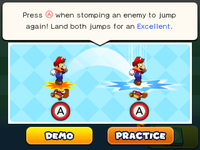
In Mario & Luigi: Paper Jam, Mario and Luigi's jumps remain the same, but Paper Mario is unique due to having as his jump button. In battle, Paper Mario and his copies can jump on enemies many times depending on how many copies he has. The Papercrafts can also perform a jump move to stomp on enemies, though the player has to retrieve the Papercraft after jumping.
Luigi's Mansion series
Luigi's Mansion: Dark Moon
In Luigi's Mansion: Dark Moon, Luigi can jump while he is sucking up a ghost to avoid attacks from other ghosts. This is executed by pressing the button while using the Poltergust 5000 to suck up the ghost.
Luigi's Mansion 3
In Luigi's Mansion 3, Luigi and Gooigi can jump by using the Burst move. Mario is also seen using his jumping abilities when he and Luigi go to rescue Peach near the end of the game.
Super Smash Bros. series
- See also: Double Jump
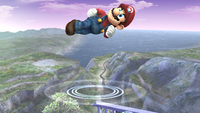
In the Super Smash Bros. series, a jump can be performed by all characters. Each character has a different jump height and speed. A major mechanic in the series is that players can jump again while airborne, and some characters can do so multiple times. Also, Mario, Luigi and Dr. Mario's Super Jump Punch is executed similarly to the conventional jumps in the Mario games.
Profiles
Super Mario Bros. 3
- Wii Virtual Console manual description: "Press
 to jump, or hold it to jump higher. When in the water, press up on
to jump, or hold it to jump higher. When in the water, press up on  and
and  to jump out of the water."
to jump out of the water." - Wii Virtual Console manual description (Super Jump): "Press
 when landing on an enemy to jump even higher."
when landing on an enemy to jump even higher."
Super Mario Land
- Virtual Console manual description: "Press
to jump. To jump higher, press and hold
or press
while running. You can adjust the direction of the jump by pressing
while in the air."
Super Mario Land 2: 6 Golden Coins
- Virtual Console manual description: "Press
to jump up. Use
to adjust the height and trajectory. You can defeat many enemies by jumping on them."
Mario & Luigi: Bowser's Inside Story
- Instruction manual description (overworld; basic actions): "Hit blocks and other things from below, and jump while moving to climb up platforms. When you're in the water, you can swim."
- Instruction manual description (overworld; crossing gaps): "Press
 and
and  at the same time while moving with
at the same time while moving with to jump across gaps."
- Instruction manual description (battle): "If you time your jump attack right, you can stomp an enemy twice."
Super Mario 3D Land
- North American Website Bio: "Mario's iconic jump is a vital move to master in every stage."
New Super Mario Bros. 2
- European Website bio: "Press the A or B Button to jump, hold the button down to jump a little higher, or jump while dashing to go higher still! To perform Double Jumps or Triple Jumps, dash and jump twice or three times in a row. The timing is pretty exact, but you can make some mighty leaps!"
Mario & Luigi: Dream Team
- Instruction manual description (overworld): "Jump to hit blocks from below or to reach higher places."
- Instruction manual description (battle): "Press the action button just before you land a jump on an enemy to attack twice."
Mario & Luigi: Paper Jam
- Instruction manual description (overworld): "Jumping can help you reach higher places or hit blocks."
- Instruction manual description (battle): "If you press the action button just before you land on an enemy, you'll jump off and repeat the action for additional damage."
- Instruction manual description (Paper Mario): "If you press
when a Paper Mario copy stomps on an enemy, the next copy in line will perform a stomp. This repeats until the copies run out or you miss a button press."
Gallery
New Super Mario Bros. U/New Super Luigi U/New Super Mario Bros. U Deluxe
Names in other languages
| Language | Name | Meaning | Notes |
|---|---|---|---|
| Japanese | ジャンプ[?] janpu |
Jump | |
| Dutch | Springen Sprong[?] |
To jump Jump |
|
| German | Springen Sprung[?] |
To jump Jump |
|
| Italian | Salto[?] | Jump | |
| Korean | 점프[?] jeompeu |
Jump | |
| Portuguese | Saltar Salto[?] |
To jump Jump |
|
| Russian | Прыжок[?] Pryzhok |
Jump | |
| Spanish | Saltar Salto[?] |
To jump Jump |
References
- ^ http://us.wii.com/iwata_asks/nsmb/vol1_page1.jsp
- ^ Nintendo Mario Mania Player's Guide. Page 43.
- Jumps
- Donkey Kong Moves
- Donkey Kong (game)
- Donkey Kong Jr.
- Donkey Kong 64
- Donkey Kong Country
- Donkey Kong Country 2: Diddy's Kong Quest
- Donkey Kong Country 3: Dixie Kong's Double Trouble!
- Donkey Kong Country Returns
- Donkey Kong Country: Tropical Freeze
- Donkey Kong Land
- Donkey Kong Land 2
- Donkey Kong Land III
- Luigi's Mansion: Dark Moon
- Mario + Rabbids Kingdom Battle
- Mario & Luigi: Bowser's Inside Story Moves
- Mario & Luigi: Dream Team Moves
- Mario & Luigi: Paper Jam Moves
- Mario & Luigi: Partners in Time Moves
- Mario & Luigi: Superstar Saga Moves
- Mario Bros.
- New Super Luigi U
- New Super Mario Bros. 2
- New Super Mario Bros. U
- New Super Mario Bros. Wii
- New Super Mario Bros.
- Nintendo Land
- Paper Mario Special Moves
- Paper Mario: Color Splash
- Paper Mario: Sticker Star
- Paper Mario: The Thousand-Year Door Moves
- Super Mario 3D Land
- Super Mario 3D World
- Super Mario 64
- Super Mario 64 DS
- Super Mario Advance 4: Super Mario Bros. 3
- Super Mario Bros. 2
- Super Mario Bros. 3
- Super Mario Bros.
- Super Mario Bros.: The Lost Levels
- Super Mario Galaxy
- Super Mario Galaxy 2
- Super Mario Land
- Super Mario Land 2: 6 Golden Coins
- Super Mario Maker
- Super Mario Odyssey
- Super Mario RPG: Legend of the Seven Stars Moves
- Super Mario Run
- Super Mario Sunshine
- Super Mario World
- Super Mario World 2: Yoshi's Island
- Super Paper Mario Moves
- Super Princess Peach
- Super Smash Bros.
- Super Smash Bros. Brawl
- Super Smash Bros. for Nintendo 3DS / Wii U
- Super Smash Bros. Melee
- Super Smash Bros. Series Moves
- Virtual Boy Wario Land
- Wario Moves
- Wario Land: Shake It!
- Wario Land: Super Mario Land 3
- Wario Land 3
- Wario Land 4
- Wario Land II
- Wario World
- Yoshi Moves
- Yoshi Touch & Go
- Yoshi's New Island
- Yoshi's Island DS
- Yoshi's Island: Super Mario Advance 3
- Yoshi's Story
- Yoshi's Woolly World



